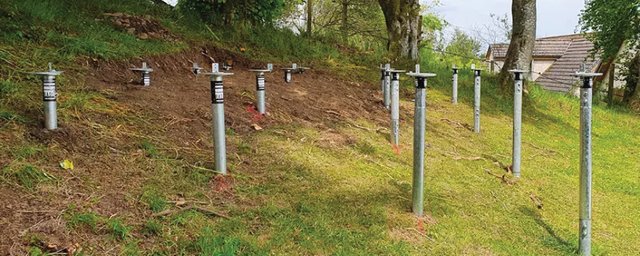How Deep Do Ground Screws Need To Be?

Ground screws, also known as earth anchors, are a type of deep foundation that provides superior load-bearing capacity and stability compared to traditional concrete foundations. These screw-like steel shafts are earth anchors, screwed into the ground using hydraulic machinery, creating a secure anchorage in load-bearing soil strata.
When it comes to ground screw installation, determining the appropriate depth is crucial. The embedment depth affects the load-bearing capacity, stability, and longevity of the foundation. Here’s a comprehensive guide to help you understand how deep your ground screws need to be driven:
Soil Conditions: The depth of ground screw installation largely depends on the soil type and its load-bearing capacity. In areas with soft or loose soil, ground screws may need to be driven deeper to reach a stable, load-bearing stratum.
Ground Screw Length: Longer ground screws allow for deeper embedment depths compared to shorter ones. Rajog offers a range of lengths up to 14 feet.
Ground Screw Foundation Depth: As a general rule, ground screws should be installed to a minimum depth where they can be anchored securely into load-bearing soil or bedrock. This depth can vary from project to project, but it’s typically recommended to extend at least 6 feet (1.8 meters) below the ground surface.
Maximum Depth for Ground Screws: While there’s no definitive maximum depth, ground screws are typically installed up to a depth of 20 feet (6 meters). Beyond this depth, specialized equipment and techniques may be required, potentially increasing installation costs and complexity.
Frost Line Considerations: In regions with freezing temperatures, ground screws must be installed below the frost line to prevent heaving or uplift caused by freezing and thawing cycles. The frost line depth can vary based on local climate conditions, but it’s generally recommended to install ground screws at least 4 feet (1.2 meters) below the frost line.
Load Requirements: The depth of ground screw installation is also influenced by the anticipated loads the foundation will need to support. Heavier loads, such as those from multi-story buildings or industrial structures, may necessitate deeper installation to ensure sufficient load-bearing capacity.
Structure Type and Usage: The intended use of the structure plays a role. For example, ground screws for a residential deck may only need to go 5-7 feet deep, while those for a commercial building may require 10+ feet.
Local Building Codes: Many areas have specific building code requirements dictating minimum depths for different types of ground anchors and foundations based on geography and climate.
INSTALLATION PROCESS PROPER INSTALLATION IS KEY TO ENSURING GROUND SCREWS ACHIEVE THEIR FULL LOAD- BEARING POTENTIAL AT THE SPECIFIED DEPTH:
Pilot Hole Boring: In dense soils, a pilot hole is first bored using an auguring machine. The ground screw is then driven into this pre-bored hole.
Torque Monitoring: An hydraulic drive head applies torque to rotate the ground screw into the ground while monitoring torque values to maximize holding strength.
Load Testing: Static or dynamic load tests can verify the installed ground screw capacity before proceeding with the project.
Engineering Calculations For many commercial, industrial, and civic projects, engineering calculations are required to properly size ground screws and determine embedment depths based on:
Structural loading data
Soil reports identifying substrate types
Building code and site-specific requirements
Get to know more interesting information at : https://rajoggroundscrew.com/blog/blogs/